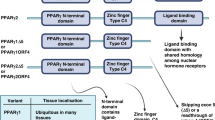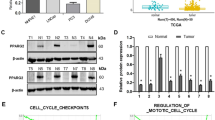Abstract
Peroxisome proliferator-activated receptor-gamma (PPARγ) regulates the interface between cellular lipid metabolism, redox status and organelle differentiation. Conditional prostatic epithelial knockout of PPARγ in mice resulted in focal hyperplasia which developed into mouse prostatic intraepithelial neoplasia (mPIN). The grade of PIN became more severe with time. Electron microscopy (EM) showed accumulated secondary lysosomes containing cellular organelles and debris suggestive of autophagy. Consistent with this analysis the autophagy marker LC-3 was found to be upregulated in areas of PIN in PPARγ KO tissues. We selectively knocked down PPARγ2 isoform in wild-type mouse prostatic epithelial cells and examined the consequences of this in a tissue recombination model. Histopathologically grafted tissues resembled the conditional PPARγ KO mouse prostates. EM studies of PPARγ- and PPARγ2-deficient epithelial cells in vitro were suggestive of autophagy, consistent with the prostatic tissue analysis. This was confirmed by examining expression of beclin-1 and LC-3. Gene expression profiling in PPARγ-/γ2-deficient cells indicated a major dysregulation of cell cycle control and metabolic signaling networks related to peroxisomal and lysosomal maturation, lipid oxidation and degradation. The putative autophagic phenotypes of PPARγ-deficient cells could be rescued by re-expression of either γ1 or γ2 isoform. We conclude that disruption of PPARγ signaling results in autophagy and oxidative stress during mPIN pathogenesis.
Similar content being viewed by others
Log in or create a free account to read this content
Gain free access to this article, as well as selected content from this journal and more on nature.com
or
Abbreviations
- Pca:
-
prostate cancer or prostate carcinoma
- PIN:
-
prostatic intraepithelial neoplasia
- PPRE:
-
peroxisome proliferator response element
- mPrE:
-
a non-malignant mouse prostate epithelial cell line spontaneously immortalized from an adult wild-type C57Bl6 mouse
- mPrE-PPARγ KO (mPrE-γKO):
-
a PPARγ knockout mouse prostate epithelial cell line spontaneously immortalized from an adult PBCre4 tg/0/PPARγ flox/flox mouse prostate
- mPrE-pSIR-PPARγ2 shRNA (mPrE-γ2sh):
-
a PPARγ2 knockdown mouse prostate epithelial cell line transfected by U6-mouse PPARγ2 shRNA in pSIR retroviral vector into mPrE cells
- mPrE-pSIR-empty vector (mPrE-pSIR):
-
a control pSIR vector-transfected mouse prostate epithelial cell line
- mPrE-PPARγKO-PPARγ1 wild-type (WT) (mPrE-γKO-γ1WT):
-
mPrE-γKO overexpressing mouse PPARγ1 WT full-length cDNA
- mPrE-PPARγKO-PPARγ2 wild-type (WT) (mPrE-γKO-γ2WT):
-
mPrE-γKO overexpressing mouse PPARγ2 WT full-length cDNA
- mPrE-PPARγKO-empty vector (EV) (mPrE-γKO-EV) transduction control:
-
mPrE-γKO retrovirally transduced using a control empty vector
- UGS:
-
urogenital sinus
- UGM:
-
urogenital mesenchymal cell
- KO:
-
knockout
- KD:
-
knockdown
References
Yu K, Bayona W, Kallen CB, Harding HP, Ravera CP, McMahon G et al. Differential activation of peroxisome proliferator-activated receptors by eicosanoids. J Biol Chem 1995; 270: 23975–23983.
Hihi AK, Michalik L, Wahli W . PPARs: transcriptional effectors of fatty acids and their derivatives. Cell Mol Life Sci 2002; 59: 790–798.
Tontonoz P, Hu E, Graves RA, Budavari AI, Spiegelman BM . mPPAR gamma 2: tissue-specific regulator of an adipocyte enhancer. Genes & development 1994; 8: 1224–1234.
Michalik L, Desvergne B, Dreyer C, Gavillet M, Laurini RN, Wahli W . PPAR expression and function during vertebrate development. The International journal of developmental biology 2002; 46: 105–114.
Mao-Qiang M, Fowler AJ, Schmuth M, Lau P, Chang S, Brown BE et al. Peroxisome-proliferator-activated receptor (PPAR)-gamma activation stimulates keratinocyte differentiation. J Invest Dermatol 2004; 123: 305–312.
Sarraf P, Mueller E, Jones D, King FJ, DeAngelo DJ, Partridge JB et al. Differentiation and reversal of malignant changes in colon cancer through PPARgamma. Nature medicine 1998; 4: 1046–1052.
Saez E, Tontonoz P, Nelson MC, Alvarez JG, Ming UT, Baird SM et al. Activators of the nuclear receptor PPARgamma enhance colon polyp formation. Nature medicine 1998; 4: 1058–1061.
Shappell SB, Gupta RA, Manning S, Whitehead R, Boeglin WE, Schneider C et al. 15S-Hydroxyeicosatetraenoic acid activates peroxisome proliferator-activated receptor gamma and inhibits proliferation in PC3 prostate carcinoma cells. Cancer research 2001; 61: 497–503.
Hsi LC, Wilson LC, Eling TE . Opposing effects of 15-lipoxygenase-1 and -2 metabolites on MAPK signaling in prostate. Alteration in peroxisome proliferator-activated receptor gamma. J Biol Chem 2002; 277: 40549–40556.
Karin M, Ben-Neriah Y . Phosphorylation meets ubiquitination: the control of NF-[kappa]B activity. Annu Rev Immunol 2000; 18: 621–663.
Michalik L, Desvergne B, Wahli W . Peroxisome-proliferator-activated receptors and cancers: complex stories. Nature reviews 2004; 4: 61–70.
Mueller E, Smith M, Sarraf P, Kroll T, Aiyer A, Kaufman DS et al. Effects of ligand activation of peroxisome proliferator-activated receptor gamma in human prostate cancer. Proceedings of the National Academy of Sciences of the United States of America 2000; 97: 10990–10995.
Hisatake JI, Ikezoe T, Carey M, Holden S, Tomoyasu S, Koeffler HP . Down-Regulation of prostate-specific antigen expression by ligands for peroxisome proliferator-activated receptor gamma in human prostate cancer. Cancer research 2000; 60: 5494–5498.
Smith MR, Kantoff PW . Peroxisome proliferator-activated receptor gamma (PPargamma) as a novel target for prostate cancer. Invest New Drugs 2002; 20: 195–200.
Li M, Jiang X, Liu D, Na Y, Gao GF, Xi Z . Autophagy protects LNCaP cells under androgen deprivation conditions. Autophagy 2008; 4: 54–60.
Chang CL, Liao JJ, Huang WP, Lee H . Lysophosphatidic acid inhibits serum deprivation-induced autophagy in human prostate cancer PC-3 cells. Autophagy 2007; 3: 268–270.
Cao C, Subhawong T, Albert JM, Kim KW, Geng L, Sekhar KR et al. Inhibition of mammalian target of rapamycin or apoptotic pathway induces autophagy and radiosensitizes PTEN null prostate cancer cells. Cancer research 2006; 66: 10040–10047.
Shappell SB, Thomas GV, Roberts RL, Herbert R, Ittmann MM, Rubin MA et al. Prostate pathology of genetically engineered mice: definitions and classification. The consensus report from the Bar Harbor meeting of the Mouse Models of Human Cancer Consortium Prostate Pathology Committee. Cancer research 2004; 64: 2270–2305.
Park JH, Walls JE, Galvez JJ, Kim M, Abate-Shen C, Shen MM et al. Prostatic intraepithelial neoplasia in genetically engineered mice. The American journal of pathology 2002; 161: 727–735.
Day KC, McCabe MT, Zhao X, Wang Y, Davis JN, Phillips J et al. Rescue of embryonic epithelium reveals that the homozygous deletion of the retinoblastoma gene confers growth factor independence and immortality but does not influence epithelial differentiation or tissue morphogenesis. J Biol Chem 2002; 277: 44475–44484.
Brockman JA, Gupta RA, Dubois RN . Activation of PPARgamma leads to inhibition of anchorage-independent growth of human colorectal cancer cells. Gastroenterology 1998; 115: 1049–1055.
Munafo DB, Colombo MI . A novel assay to study autophagy: regulation of autophagosome vacuole size by amino acid deprivation. Journal of cell science 2001; 114 (Pt 20): 3619–3629.
Zhang J, Fu M, Cui T, Xiong C, Xu K, Zhong W et al. Selective disruption of PPARgamma 2 impairs the development of adipose tissue and insulin sensitivity. Proceedings of the National Academy of Sciences of the United States of America 2004; 101: 10703–10708.
Yang MS, Ji KA, Jeon SB, Jin BK, Kim SU, Jou I et al. Interleukin-13 enhances cyclooxygenase-2 expression in activated rat brain microglia: implications for death of activated microglia. J Immunol 2006; 177: 1323–1329.
Jiang M, Shappell SB, Hayward SW . Approaches to understanding the importance and clinical implications of peroxisome proliferator-activated receptor gamma (PPARg) signaling in prostate cancer. J Cell Biochem 2004; 91: 513–527.
Pathak SK, Sharma RA, Steward WP, Mellon JK, Griffiths TR, Gescher AJ . Oxidative stress and cyclooxygenase activity in prostate carcinogenesis: targets for chemopreventive strategies. Eur J Cancer 2005; 41: 61–70.
Shappell SB, Boeglin WE, Olson SJ, Kasper S, Brash AR . 15-lipoxygenase-2 (15-LOX-2) is expressed in benign prostatic epithelium and reduced in prostate adenocarcinoma. The American journal of pathology 1999; 155: 235–245.
Shappell SB, Keeney DS, Zhang J, Page R, Olson SJ, Brash AR . 15-Lipoxygenase-2 expression in benign and neoplastic sebaceous glands and other cutaneous adnexa. J Invest Dermatol 2001; 117: 36–43.
Kirschenbaum A, Liotta DR, Yao S, Liu XH, Klausner AP, Unger P et al. Immunohistochemical localization of cyclooxygenase-1 and cyclooxygenase-2 in the human fetal and adult male reproductive tracts. The Journal of clinical endocrinology and metabolism 2000; 85: 3436–3441.
Bostwick DG, Meiers I, Shanks JH . Glutathione S-transferase: differential expression of alpha, mu, and pi isoenzymes in benign prostate, prostatic intraepithelial neoplasia, and prostatic adenocarcinoma. Human pathology 2007; 38: 1394–1401.
Keen HL, Ryan MJ, Beyer A, Mathur S, Scheetz TE, Gackle BD et al. Gene expression profiling of potential PPARgamma target genes in mouse aorta. Physiological genomics 2004; 18: 33–42.
Perera RJ, Marcusson EG, Koo S, Kang X, Kim Y, White N et al. Identification of novel PPARgamma target genes in primary human adipocytes. Gene 2006; 369: 90–99.
Hippert MM, O’Toole PS, Thorburn A . Autophagy in cancer: good, bad, or both? Cancer research 2006; 66: 9349–9351.
Bergmann A . Autophagy and cell death: no longer at odds. Cell 2007; 131: 1032–1034.
Degenhardt K, Mathew R, Beaudoin B, Bray K, Anderson D, Chen G et al. Autophagy promotes tumor cell survival and restricts necrosis, inflammation, and tumorigenesis. Cancer cell 2006; 10: 51–64.
Maiuri MC, Zalckvar E, Kimchi A, Kroemer G . Self-eating and self-killing: crosstalk between autophagy and apoptosis. Nat Rev Mol Cell Biol 2007; 8: 741–752.
Jones JR, Shelton KD, Guan Y, Breyer MD, Magnuson MA . Generation and functional confirmation of a conditional null PPARgamma allele in mice. Genesis 2002; 32: 134–137.
Wu X, Wu J, Huang J, Powell WC, Zhang J, Matusik RJ et al. Generation of a prostate epithelial cell-specific Cre transgenic mouse model for tissue-specific gene ablation. Mechanisms of development 2001; 101: 61–69.
Duan SZ, Ivashchenko CY, Russell MW, Milstone DS, Mortensen RM . Cardiomyocyte-specific knockout and agonist of peroxisome proliferator-activated receptor-gamma both induce cardiac hypertrophy in mice. Circulation research 2005; 97: 372–379.
Acknowledgements
The authors appreciate EM core lab members for help with E.M., Vanderbilt MCN III Animal facility for animal care, Vanderbilt Microarray Shared Resource (VMSR) facility for microarray work. The pCMX-mouse PPARγ1 and PPARγ2 wild-type full-length cDNA expression plasmids and PPARγ-Luciferase reporter plasmid (PPRE)3-tk-luciferase were gifts from Dr. V.K.K. Chatterjee, University of Cambridge, Cambridge, UK. The pQCXIP-mouse PPARγ1 and PPARγ2 wild-type full-length cDNA vectors were gifts from Drs. Y. Eugene Chen and Jifeng Zhang, University of Michigan Medical Center. The CK-14 (LL001) antibody was a gift from Dr. EB Lane, Universty of Dundee, Scotland and the α-LC-3 antiserum from Dr. Tamotsu Yoshimori, National Institute of Genetics (NIG), Mishima, Japan. The work was supported by NIH R01 DK67049 and DOD-PCRP, W81XWH-07-1-0479 grants to S.W.H. NIH R01 CA113392 and NIH R01 CA59705 grants to P.R-B, NIH R01 DK055748 to R.J.M. The VUMC Research EM Resource is supported by NIH grants DK20539, CA68485 and DK58404. The Vanderbilt Microarray Shared Resource is supported by the Vanderbilt Ingram Cancer Center (P30 CA68485), the Vanderbilt Digestive Disease Center (P30 DK58404) and the Vanderbilt Vision Center (P30 EY08126). We also thank the Frances Williams Preston Laboratories of the TJ Martell Foundation for support. The content of this paper is solely the responsibility of the authors and does not necessarily represent the official views of the National Institutes of Health.
Author information
Authors and Affiliations
Corresponding authors
Additional information
Edited by HU Simon
Supplementary Information accompanies the paper on Cell Death and Differentiation website (http://www.nature.com/cdd)
Rights and permissions
About this article
Cite this article
Jiang, M., Fernandez, S., Jerome, W. et al. Disruption of PPARγ signaling results in mouse prostatic intraepithelial neoplasia involving active autophagy. Cell Death Differ 17, 469–481 (2010). https://doi.org/10.1038/cdd.2009.148
Received:
Revised:
Accepted:
Published:
Issue date:
DOI: https://doi.org/10.1038/cdd.2009.148
Keywords
This article is cited by
-
Metformin regulates multiple signaling pathways within castration-resistant human prostate cancer cells
BMC Cancer (2022)
-
MAOA-a novel decision maker of apoptosis and autophagy in hormone refractory neuroendocrine prostate cancer cells
Scientific Reports (2017)
-
Taurine protects against As2O3-induced autophagy in livers of rat offsprings through PPARγ pathway
Scientific Reports (2016)
-
Neuroprotective Effects of Paeoniflorin on 6-OHDA-Lesioned Rat Model of Parkinson’s Disease
Neurochemical Research (2016)
-
15d-Prostaglandin J2 Protects Cortical Neurons Against Oxygen–Glucose Deprivation/Reoxygenation Injury: Involvement of Inhibiting Autophagy Through Upregulation of Bcl-2
Cellular and Molecular Neurobiology (2015)



